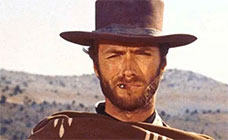|
|
|
|
The Good, the Bad and the Ugly
|
 |
If
you want to appreciate the genius of Sergio Leone, follow the trail of
smouldering cigars in The Good, The Bad
and The Ugly. That is certainly what Tuco (Eli Wallach) does as he pursues
Blondie (Clint Eastwood) across the barren plains of the American Old West (in
actuality, Spain).
Smokers
may well be in the best position to enjoy this movie. Cigars fill many
narrative functions, from a prop in the gruesome, near-death masquerade staged
by Tuco and Blondie as they wander from place to place, to a way of lighting
explosives. And the expansive moments when his characters take a long, pleasant
puff – glorified by the magisterial music of Ennio Morricone – are spectacles
of sheer joy, when Leone reveals his talent at creating and filming human
gesture.
In
this scenario, Leone and his frequent writer Luciano Vincenzoni label Tuco as
“the ugly” and Blondie as “the good”. The epithet of “the bad” is reserved for
Angel Eyes (Lee Van Cleef), a truly nasty piece of work who crosses over from
mercenary to military officer during the Civil War.
Critics
in the 1960s and ‘70s turned over the multiple ironies of the film’s title,
wondering who really should be called good, bad or ugly. Frankly, this sort of
literary speculation is largely beside the point. Everybody in this movie is
rotten to the core. Basic, animalistic values of greed and survival are the
only things that drive them.
If
you have ever wondered, as a film fan or a filmmaker, how bad guys can be made
enjoyable, this is the movie for you. (It has certainly proved to be the movie
for Quentin Tarantino.) Leone stages every
encounter between the three men as a simultaneously gruelling and hilarious
game of wits and bluff. Oneupmanship becomes the supreme value in life, and
also the supreme achievement.
Leone
views the power play of his characters with sheer delight. The most surprised
party in any transaction is likely to be the viewer – Leone never ceases toying
with our moment-to-moment expectations.
The
opening scene is classic Leone. There is a vast, widescreen landscape, suddenly
blotted out by an ugly, unshaven face. This man approaches two others with
agonising slowness. We anticipate a classic Western shootout.
But,
just as the three men approach the door of a house, they all burst in at once,
an integrated unit in search of a hitherto invisible target. There is
off-screen gunfire, and then Tuco appears through a window, frozen amid a hail
of broken glass as he pulls a face and chomps on his lunch. When we finally
peek through that door, the three visitors are dead.
The Good, The Bad
and The Ugly now comes to us in a newly restored form, with an extra 20 minutes that
originally appeared in the Italian version but have never been dubbed into
English until now. Seeing this film on a big screen with the sound turned up
loud is an incomparable experience of pure cinema.
At
its full length, the inspired construction of the piece is more evident than
before. It begins in a deliberately pared down, minimalist way, rotating its
three main characters. Slowly, Leone begins adding details that construct a
historical portrait of the Civil War.
This
is Leone’s first real venture into the realm of the epic, an investigation he
would continue to master in Once Upon a
Time in the West (1970) and his final testament, Once Upon a Time in America (1984).
The Good, The Bad
and The Ugly culminates in a closing 40 minutes that includes three immortal set pieces – a
trifecta that very few filmmakers could ever pull off. Each of these scenes
expresses a different facet of Leone’s art.
The
first set piece is about the brutal ironies that inform history. Tuco and
Blondie want to get to the stash buried in a graveyeard, so they blow up a
bridge that is a vital link in the War. Once it explodes, the cannon fire from both sides escalates. When the smoke
clears, it seems that (in a stunning ellipse) some soldiers have decamped,
while many others are strewn dead on the battlefield. This, in a nutshell, is
Leone’s vision of politics as the ultimate, perfectly meaningless Inferno.
The
second set piece, following immediately on from the first, involves Tuco in the
graveyard. Infinite riches are his – if only he can find one, particular grave
in a field of thousands. As he skips madly from headstone to headstone, Leone’s
camera spins and blurs (taking brilliant advantage of an inherent limitation of
the motion picture apparatus – pan shots that “streak”). Wallach (in the finest
role of his career) conveys, in this sublime dance, both the ecstasy of a
savage child and his dawning sense of utter desperation and hopelessness.
And
then there is the final shootout – three bad men in a wide circle, waiting to
see who will fire first. It is a scene that has been endlessly copied and
parodied in everything from Monty
Python’s Flying Circus to Robert Rodriguez’s Desperado (1995). But even the
most jaded moviegoer’s laughter will turn to awe as Leone turns on and sustains
the cinematic pyrotechnics that are his trademarks: the accelerating editing,
the close-ups of eyes, the ultimate moment of truth.
Leone
is, I believe, an underrated figure in cinema history, one of its greatest and
most radical innovators. Ultimately, there is nothing in contemporary
filmmaking that approaches the special kind of thrill that The Good, The Bad and The Ugly can give.
MORE Leone: Gił la testa © Adrian Martin August 2003 |
![]()